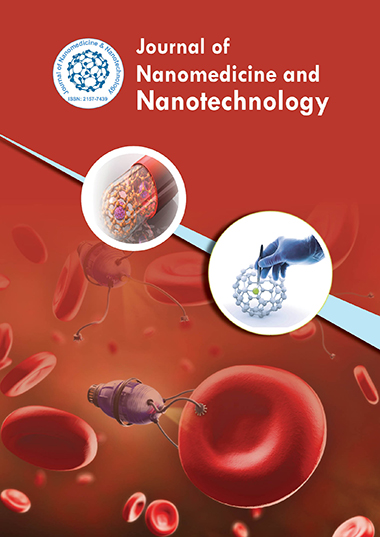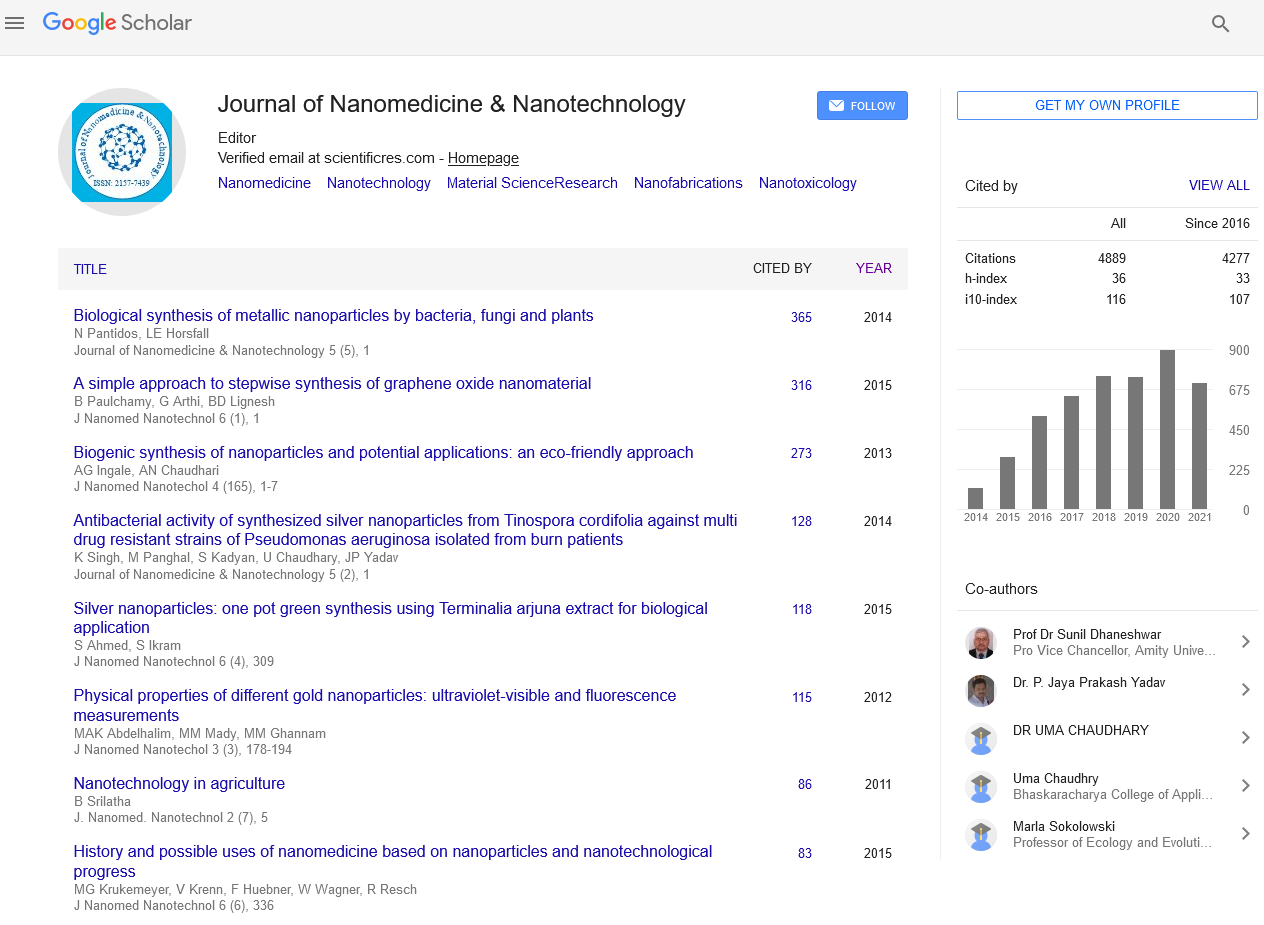Indexed In
- Open J Gate
- Genamics JournalSeek
- Academic Keys
- JournalTOCs
- ResearchBible
- China National Knowledge Infrastructure (CNKI)
- Scimago
- Ulrich's Periodicals Directory
- Electronic Journals Library
- RefSeek
- Hamdard University
- EBSCO A-Z
- OCLC- WorldCat
- SWB online catalog
- Virtual Library of Biology (vifabio)
- Publons
- MIAR
- Scientific Indexing Services (SIS)
- Euro Pub
- Google Scholar
Useful Links
Share This Page
Journal Flyer

Open Access Journals
- Agri and Aquaculture
- Biochemistry
- Bioinformatics & Systems Biology
- Business & Management
- Chemistry
- Clinical Sciences
- Engineering
- Food & Nutrition
- General Science
- Genetics & Molecular Biology
- Immunology & Microbiology
- Medical Sciences
- Neuroscience & Psychology
- Nursing & Health Care
- Pharmaceutical Sciences
Short Communication - (2025) Volume 16, Issue 2
Nanoparticles in Medicine: Revolutionizing Drug Delivery and Diagnostics
Astrid Vargstrom*Received: 01-Mar-2025, Manuscript No. jnmnt-25-28610; Editor assigned: 05-Mar-2025, Pre QC No. jnmnt-25-28610; Reviewed: 20-Mar-2025, QC No. jnmnt-25-28610; Revised: 25-Mar-2025, Manuscript No. jnmnt-25-28610; Published: 31-Mar-2025
Abstract
Nanoparticles have emerged as a transformative tool in medicine, particularly in drug delivery and diagnostics. Their unique physicochemical properties, including high surface area, tunable size, and the ability to be functionalized, allow for precise targeting, controlled drug release, and enhanced imaging capabilities. Nanoparticle-based systems offer significant advantages over traditional medical approaches, including improved bioavailability, reduced side effects, and enhanced sensitivity in disease detection. Despite these promising benefits, challenges such as biocompatibility, toxicity, and large-scale production must be addressed to fully integrate nanoparticles into mainstream medical applications. This article explores the role of nanoparticles in revolutionizing drug delivery and diagnostics, discussing their benefits, challenges, and future prospects
Keywords
Nanoparticles; Medicine; Drug delivery; Diagnostics; Nanotechnology; Targeted therapy; Imaging; Biocompatibility; Biomedical applications; Nanomedicine
INTRODUCTION
The field of nanomedicine has seen remarkable growth in recent years, with nanoparticles playing a crucial role in enhancing drug delivery and diagnostics. Traditional methods often face limitations such as poor bioavailability, systemic toxicity, and inefficiencies in targeting specific tissues or diseases. Nanoparticles, due to their small size and ability to be engineered at the molecular level, offer solutions to these challenges. They enable precise drug targeting, reduce side effects, and improve diagnostic accuracy through advanced imaging techniques. With ongoing research and technological advancements, nanoparticles are set to redefine the landscape of modern medicine [1,2].
DESCRIPTION
Nanoparticles in medicine can be categorized based on their composition and functionality:
Liposomes and polymeric nanoparticles: These biodegradable carriers allow for controlled drug release, reducing systemic toxicity and enhancing therapeutic efficacy [3,4].
Metallic nanoparticles (Gold, Silver, Iron Oxide): Used in imaging and diagnostics, these nanoparticles improve contrast in MRI scans and enable targeted photothermal therapy for cancer treatment.
Quantum dots: Semiconductor nanoparticles that enhance fluorescent imaging, enabling early disease detection and precise cellular tracking [5].
Dendrimers and carbon-based nanoparticles: These highly branched molecules and carbon-based structures, such as graphene and carbon nanotubes, improve drug solubility and delivery efficiency.
These nanoparticle-based systems enable more effective and less invasive treatments, providing new hope for tackling complex diseases such as cancer, neurodegenerative disorders, and infectious diseases [6,7].
DISCUSSION
Nanoparticles provide several advantages in drug delivery and diagnostics:
Enhanced targeting and bioavailability: Functionalized nanoparticles can deliver drugs directly to affected tissues, minimizing side effects and improving therapeutic outcomes.
Controlled release mechanisms: Nanocarriers allow for sustained and localized drug release, reducing the need for frequent dosing.
Improved imaging and diagnostics: Metallic and quantum dot nanoparticles enhance contrast and sensitivity in imaging techniques, enabling early disease detection [8,9].
Personalized medicine applications: Tailored nanoparticle-based therapies can be customized for individual patients, optimizing treatment efficacy.
However, challenges remain:
Biocompatibility and toxicity: Some nanoparticles accumulate in organs and may cause adverse effects, necessitating further safety studies [10].
Manufacturing and scalability: Large-scale production of consistent and high-quality nanoparticles remains a challenge for widespread clinical adoption.
Regulatory and ethical concerns: Approval processes for nanomedicine are complex, requiring extensive evaluation to ensure safety and efficacy.
Addressing these challenges requires interdisciplinary collaboration between scientists, medical professionals, and regulatory agencies to unlock the full potential of nanoparticles in medicine.
CONCLUSION
Nanoparticles are revolutionizing drug delivery and diagnostics, offering unprecedented precision, efficiency, and versatility. Their ability to enhance targeted therapy and improve imaging techniques makes them invaluable in modern healthcare. While obstacles such as safety concerns and large-scale production persist, ongoing research and innovation continue to drive progress in the field. With further advancements, nanoparticles hold the promise of transforming medicine, leading to more effective treatments, earlier disease detection, and improved patient outcomes.
ACKNOWLEDGEMENT
None
CONFLICT OF INTEREST
None
REFERENCES
- Villegas R, Ramírez L, Guevara H, Sicairos P, Ayala H, Sanchez L. Synthesis and characterization of magnetite nanoparticles for photocatalysis of nitrobenzene. Journal of Saudi Chemical Society.2020;24(2): 223-235.
- Newbury E, Ritchie W. Is scanning electron microscopy/energy dispersive X‐ray spectrometry (SEM/EDS) quantitative? Scanning. 2013; 35(3):141-168.
- Pan Z, Lin Y, Sarkar B, Owens G, Chen Z. Green synthesis of iron nanoparticles using red peanut skin extract: Synthesis mechanism, characterization and effect of conditions on chromium removal. Journal of Colloid and Interface Science.2020; 558: 106-114.
- Qu S, Huang F, Yu S, Chen G, Kong J. Magnetic removal of dyes from aqueous solution using multi-walled carbon nanotubes filled with Fe2O3 particles. Journal of Hazardous Materials.2008; 160(2-3): 643-647.
- KaradeV, Waifalkar P, Dongle T, Sahoo S C, Kollu P, Patil P et al. Greener synthesis of magnetite nanoparticles using green tea extract and their magnetic properties. Mater Res Express.2017; 4(9): 096102.
- Li y, Jiang Y, Huang K. Ding P, Chen J. Preparation and properties of magnetic Fe3O4–chitosan nanoparticles. Journal of alloys and compounds.2008; 466(1-2): 451-456.
- Poole C P, Owens F J. Introduction to nanotechnology. 2003.
- Fulekar M. Nanotechnology: importance and applications. IK International Pvt Ltd. 2010.
- Almomani F, Bhosale R, Khraisheh M, Almomani T. Heavy metal ions removal from industrial wastewater using magnetic nanoparticles (MNP). Appl Surf Sci.2020; 506: 144924.
- Zulfiqar N. Effect of adding surfactant additives (sodium lauryl sulphate) in water on the performance of flat plate solar distillation system for the purification of water. 2023.
Indexed at, Google Scholar, Crossref
Indexed at, Google Scholar, Crossref
Indexed at, Google Scholar, Crossref
Indexed at, Google Scholar, Crossref
Indexed at, Google Scholar, Crossref
Indexed at, Google Scholar, Crossref
Indexed at, Google Scholar, Crossref
Indexed at, Google Scholar, Crossref
Citation: Astrid V (2025) Nanoparticles in Medicine: Revolutionizing Drug Delivery and Diagnostics. J Nanomed Nanotech. 16: 786.
Copyright: ©2025 Astrid V. This is an open-access article distributed under the terms of the Creative Commons Attribution License, which permits unrestricted use, distribution, and reproduction in any medium, provided the original author and source are credited.


